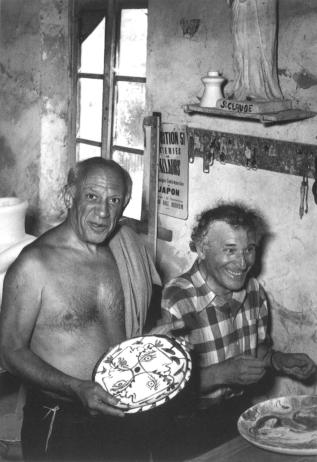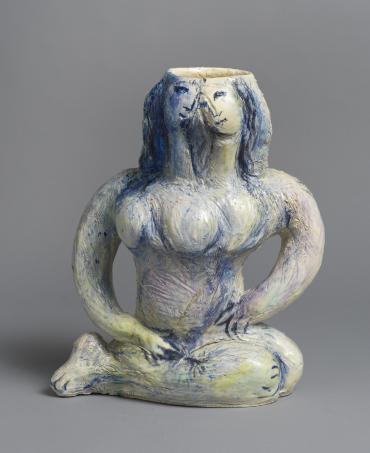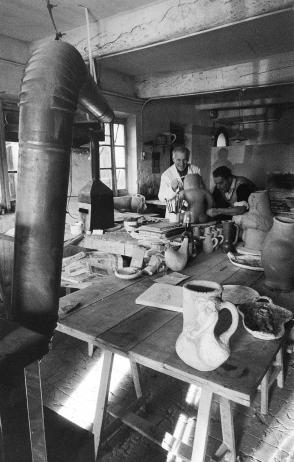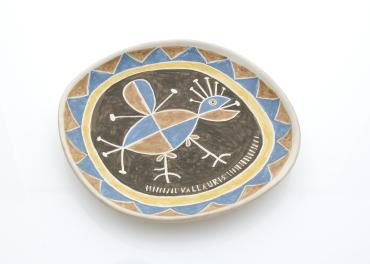The Madoura studio in Vallauris
Quitterie du Vigier
“What a wonderful time we live in, when the greatest painters enjoy becoming ceramists and potters!”1 Gaston Bachelard wrote in 1952, referring to Marc Chagall's ceramics. In the 1950s, many artists who had moved to the South of France took up ceramics. In the Vallauris region, traces of “transforming earth into utilitarian objects” date back to the Neolithic Period.2 The refractory earth3 of the town, known as Vallis Aurea (Golden Valley) since the early Middle Ages,4 fostered the development of pottery in the 16th, and especially the 17th and 18th centuries.5
This land attracted artists and craftsmen who gave it a new lease of life, including Suzanne and Georges Ramié, who founded the Madoura studio. Suzanne Ramié, née Douly (1905-1974), graduated from the École des Beaux-Arts in Lyon and worked as a textile designer before settling in Vallauris, where she trained in ceramics with Jean-Baptiste Chiapello. In 1938, she rented a disused culinary ceramics factory from the Foucard-Jourdan family of potters.6 Jules Agard, a turner, helped her. Georges Ramié, who ran a tree nursery in Théoule, joined his wife in 1940,7 and together they founded Madoura, named after the first letters of the words "Maison Douly Ramié". The studio became an essential ceramic production venue, welcoming many artists eager to try their hand at this age-old craft.
After its creation, the studio grew but remained human in scale, employing between six and seven people over the years.8 The first employee, Jules Agard, a former apprentice turner at Maison Jérôme Massier, became Suzanne's form turner in 1939, a position he held until 1970.9 He was Picasso's turner as well as that of other artists who collaborated with the studio, such as Chagall, turning pieces based on their sketches.10 By 1948, the studio was growing so quickly that Jean Derval was asked to lend a hand.11 He worked first with Robert Picault and Roger Capron,12 then at Madoura13 as a graphic designer14 until 1952,15 when Raymond Legrand replaced him.16 He took part in developing a "repertoire of forms" influenced by the Mediterranean, "Antiquity revisited, Central Asia, pre-Columbian art" and "naturalist inspirations".17 In 1953, Yvan Oreggia joined the studio, followed by Dominique Sassi.
In 1974, André Verdet, poet and creator of ceramics at Madoura, paid tribute to his friend Suzanne in a piece extolling teamwork at the studio: "Madoura is still a place where the beautiful ideas of teamwork and community are part of everyday life, where each person takes care to be in tune with the others in a constant concern for a superior product and the sole aim of surpassing oneself, so that at the end of the day everyone unreservedly enjoys the satisfying feeling of having accomplished something together."18 This testimony reveals the love of work combined with team spirit that prevailed at Madoura.
In 1940, the war and Italy’s occupation of southeastern France led Suzanne to leave for Lyon before returning to Vallauris when conditions allowed.19 During this period, the Ramiés expressed solidarity with artists in the Unoccupied Zone by sharing meals with them.20 Suzanne was the studio’s figurehead. Renée Moutard-Uldry even nicknamed her “Madoura” in a 1958 article.21 Her creations were successful and won a gold medal in 1942 at the Arts et Traditions populaires craft exhibition in Nice.22 In July 1946, the Madoura studio participated in the first postwar pottery show,23 which took place in the lobby of the Nérolium in Vallauris. Others followed.24 During the event, Picasso, who had been invited to Vallauris by the artist Giovanni Leonardi, took an interest in the Madoura pieces and met Suzanne.25 He made several test pieces in the studio and returned a year later,26 beginning a highly successful collaboration that helped to make it famous.
Assisted by Agard, Oreggia and Sassi, Picasso created many sketches, one-off pieces and limited series. He combined zoomorphic and anthropomorphic motifs, as in a vase entitled Large Bird, Black Face (1951, limited edition of 25 numbered copies) (fig.


Other artists also came to work there. In 1961, the Madoura gallery paid tribute to these collaborations with an exhibition entitled Pléiade, featuring works by 20 artists, including Picasso, Chagall, Brauner and Matisse. In 1948, Matisse created about 10 plates at the Madoura studio, including a dish (1948, Faenza Museum28) featuring a woman's head.29 Chagall surely began working there in 1951, as the famous photograph of him and Picasso at the studio attests30(fig.2).
Chagall, who also tried his hand at sculpture, confronted the "temptation of the third dimension"31 and wanted to "use this clay like the old craftsmen"32. He created many dishes, vases and shaped pieces, such as Large Figures [Grands personnages] (1962) (fig.3). Brauner, who frequented locally-based artists such as Anton Prinner, also discovered ceramics and was delighted to work at the Madoura studio in 1953. "What a curious experience for a painter!” he wrote. “You work on a painting with anxiety. Here, you work with joy...”33 He made fewer pieces than Picasso,34 consisting mainly of plates, dishes (such as Bird Dish, April 28, 1953, in the Musée Magnelli, Musée de la Céramique, Vallauris) (fig. 4), pitchers and, more seldom, anthropomorphic objects.35 Suzanne's output was distinct from that of Picasso and the other artists who worked at the studio. A 1974 tribute exhibition36 showcased several of her creations, both figurative and abstract, with minimalist overtones, including Bird, Hawk and Structured Form.



In this historic ceramic production site, clay was transformed into unique works imbued with their creators’ genius in an atmosphere fostering creativity. Art and craftsmanship met, giving rise to many ceramics by artists who have contributed to its posterity. Today, the Madoura studio, which has been preserved, belongs to the Sophia Antipolis urban community37 and is called a "place of art, history and creation". Currently closed for renovations, the exhibition space features a collection of ceramics by Picasso and Suzanne Ramié.38
Access the search for ceramics in the online catalogue raisonné of Marc Chagall